Europe Heating, Ventilation, And Air Conditioning (HVAC) Equipment Market Size 2024-2028
The Europe heating, ventilation, and air conditioning (HVAC) equipment market size is valued to increase USD 10.8 billion, at a CAGR of 5.57% from 2023 to 2028. Growth in data centers fueling market growth will drive the Europe heating, ventilation, and air conditioning (hvac) equipment market.
Major Market Trends & Insights
- By End-user - Non-residential segment was valued at USD 26.20 billion in 2022
- By Product - Air conditioning equipment segment accounted for the largest market revenue share in 2022
Market Size & Forecast
- Market Opportunities: USD 61.35 billion
- Market Future Opportunities: USD 10.80 billion
- CAGR from 2023 to 2028 : 5.57%
Market Summary
- The market is a dynamic and evolving sector, driven by advancements in core technologies and applications. With the increasing adoption of energy-efficient solutions and the growing focus on predictive maintenance, the market is poised for significant growth. According to recent reports, the European HVAC market is expected to account for over 30% of the global market share by 2025. However, the market faces challenges such as high market competition from APAC companies and stringent regulations. Despite these hurdles, opportunities abound, particularly in the data center sector, where the demand for reliable and efficient HVAC systems is surging due to the expansion of cloud computing and the increasing number of internet users.
- Overall, the European HVAC Equipment Market is a vibrant and ever-changing landscape, offering numerous opportunities for stakeholders and investors alike.
What will be the Size of the Europe Heating, Ventilation, And Air Conditioning (Hvac) Equipment Market during the forecast period?
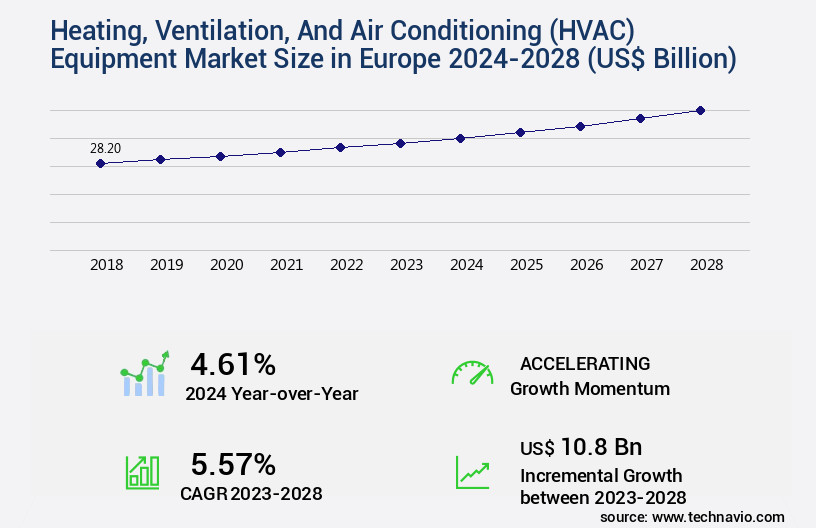
Get Key Insights on Market Forecast (PDF) Request Free Sample
How is the Heating, Ventilation, And Air Conditioning (HVAC) Equipment in Europe Market Segmented and what are the key trends of market segmentation?
The heating, ventilation, and air conditioning (hvac) equipment in Europe industry research report provides comprehensive data (region-wise segment analysis), with forecasts and estimates in "USD billion" for the period 2024-2028, as well as historical data from 2018-2022 for the following segments.
- End-user
- Non-residential
- Residential
- Product
- Air conditioning equipment
- Heating equipment
- Ventilation equipment
- Geography
By End-user Insights
The non-residential segment is estimated to witness significant growth during the forecast period.
The European HVAC Equipment Market is characterized by continuous evolution and ongoing activities, with a focus on energy efficiency, air quality, and safety. Smart HVAC controllers and building automation systems are increasingly integrated to optimize HVAC load calculations and improve system diagnostics. Air filtration technology and thermal comfort modeling are essential for maintaining healthy indoor environments and ensuring regulatory compliance with building energy codes. In the non-residential segment, industries such as oil and gas, power, pulp and paper, water and wastewater treatment, chemical and petrochemical, mining and metal, pharmaceutical, and food and beverages account for the largest share. The increasing risk of dust-related explosions in these industries necessitates the use of explosion-proof HVAC systems.
This need is further fueled by the growing number of accidents in explosion-prone environments. As a result, the market is witnessing significant growth in explosion-proof HVAC systems, including air conditioning refrigerant systems, ventilation system designs, and heating system controls. Additionally, the chiller plant operation, heat exchanger efficiency, and HVAC commissioning process are undergoing advancements to enhance system efficiency and reduce energy consumption. Key trends include the adoption of variable refrigerant flow, demand-controlled ventilation, and pneumatic control systems. The market is also witnessing the emergence of thermal storage systems, cooling tower performance optimization, and heat pump technology with energy recovery ventilation.
Overall, the European HVAC Equipment Market is poised for continued growth as it addresses the evolving needs of industries for energy efficiency, safety, and indoor air quality.
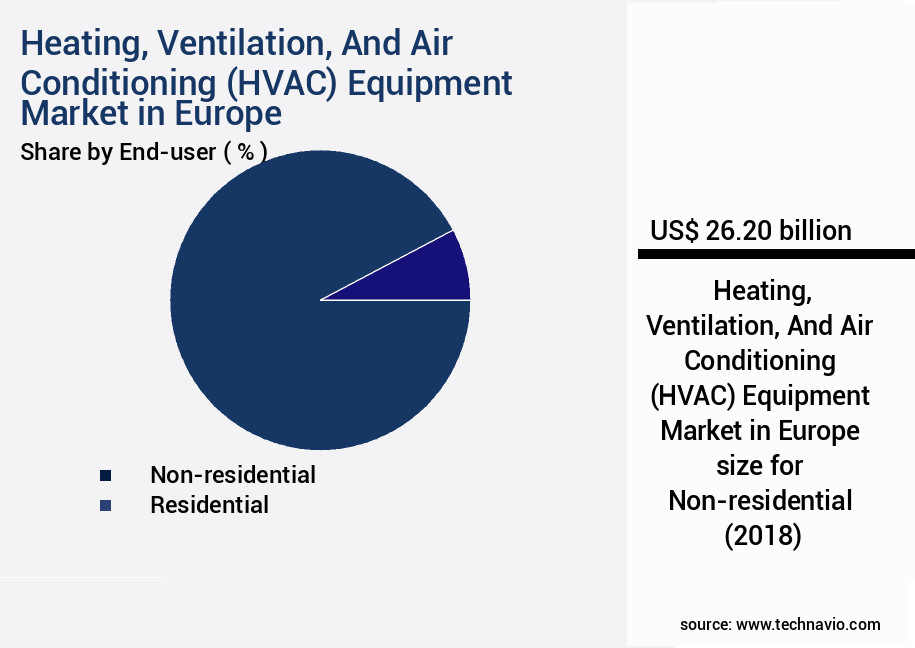
Request Free Sample
The Non-residential segment was valued at USD 26.20 billion in 2018 and showed a gradual increase during the forecast period.
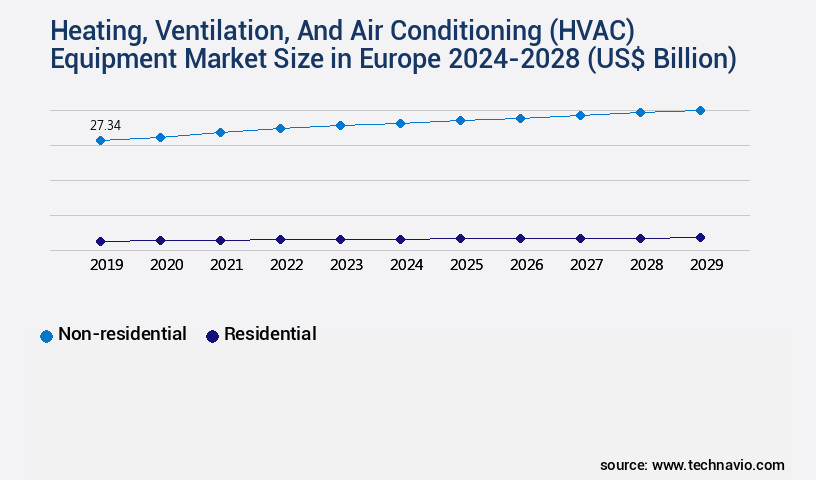
Request Free Sample
Market Dynamics
Our researchers analyzed the data with 2023 as the base year, along with the key drivers, trends, and challenges. A holistic analysis of drivers will help companies refine their marketing strategies to gain a competitive advantage.
The European HVAC market is witnessing significant growth due to the increasing focus on improving system efficiency and reducing energy consumption. One of the primary trends driving this market is the adoption of variable refrigerant flow (VRF) systems, which offer enhanced energy savings and flexibility in design. These systems enable efficient heating and cooling based on the actual demand, leading to substantial energy savings. Another crucial factor fueling the market's expansion is the growing importance of air quality monitoring sensors. Advanced sensors, such as CO2 and VOC sensors, are increasingly being integrated into HVAC systems to ensure optimal indoor air quality.
This integration not only enhances occupant comfort but also contributes to improved health and productivity. Designing energy-efficient HVAC systems is a top priority for building owners and operators. Advanced HVAC control strategies, such as adaptive control and predictive maintenance, are being implemented to optimize system performance metrics. These strategies enable real-time monitoring and analysis of system data, allowing for proactive maintenance scheduling and timely interventions to prevent potential issues. Building automation systems are also being integrated with HVAC systems to streamline operations and improve overall system performance. Advanced heat recovery systems are finding extensive applications in both new constructions and retrofits, as they offer significant energy savings by recovering and reusing waste heat.
The European HVAC market is highly competitive, with a significant number of players vying for market share. While many focus on product innovation and advanced technologies, others prioritize preventative maintenance and customer service to differentiate themselves. For instance, more than 80% of market leaders invest heavily in research and development, compared to less than 50% of other players. This investment in R&D enables these companies to introduce innovative HVAC equipment and testing methods, setting new industry standards and driving market growth.
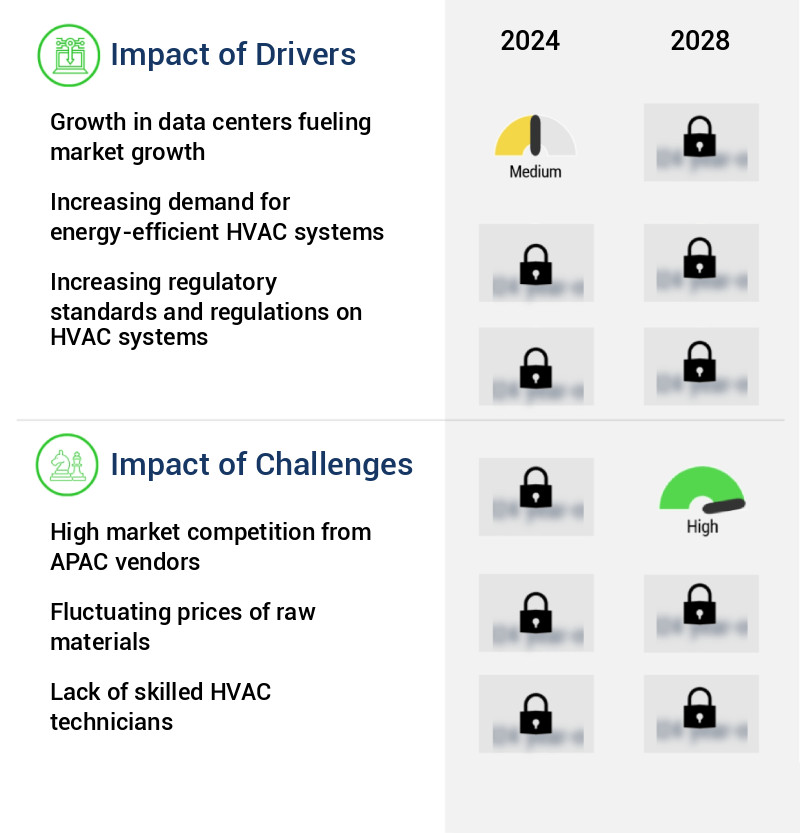
What are the key market drivers leading to the rise in the adoption of Heating, Ventilation, And Air Conditioning (HVAC) Equipment in Europe Industry?
- The expansion of data centers serves as the primary catalyst for market growth.
- A data center is a critical infrastructure that houses intricate electronic components, necessitating consistent temperature, humidity, airflow, and cleanliness to prevent equipment failure. Heating, Ventilation, and Air Conditioning (HVAC) systems play a pivotal role in data centers, as cooling is a significant expense. An insufficient cooling level can lead to server slowdowns or malfunctions, while excessive cooling can result in elevated operating costs. The escalating number of data centers has intensified the necessity to manage the vast heat generated by equipment and machinery within these facilities. The European data center market has experienced substantial expansion over the past few years and is projected to persistently grow.
- The region's data center market share is significant, driven by the increasing adoption of cloud services, digital transformation initiatives, and the growing demand for data processing and storage. Furthermore, the European Union's focus on digitalization and the implementation of stringent data protection regulations have contributed to the market's growth. The market's dynamic nature is evident in the continuous development of energy-efficient cooling technologies and the increasing integration of renewable energy sources in data center operations.
What are the market trends shaping the Heating, Ventilation, And Air Conditioning (HVAC) Equipment in Europe Industry?
- The increasing focus on predictive maintenance is a mandated market trend. This approach to maintenance ensures the proactive identification and resolution of potential equipment failures before they occur.
- The demand for Internet of Things (IoT)-enabled devices in industrial HVAC maintenance has witnessed significant growth, driven by the necessity to collect and analyze data for resolving intricate maintenance tasks. IoT technologies, such as wireless acoustic transmitters and steam trap monitors, are increasingly utilized to optimize HVAC system operations. End-users have adopted a proactive approach towards predictive maintenance, which results in reduced downtime and enhanced operational efficiency. IoT-integrated devices, like smart thermostats, play a crucial role in industrial settings.
- Equipped with sensors and Wi-Fi capabilities, these devices enable remote temperature adjustments in industrial premises via smartphones or personal computers (PCs). The implementation of the Industrial Internet of Things (IIoT) in HVAC systems is particularly advantageous for industries managing expansive operational areas. By integrating IoT technologies, HVAC systems can facilitate more efficient energy consumption, optimized performance, and improved overall system reliability.
What challenges does the Heating, Ventilation, And Air Conditioning (HVAC) Equipment in Europe Industry face during its growth?
- The intense market competition from companies in the Asia-Pacific region poses a significant challenge to the industry's growth trajectory.
- The European HVAC equipment market experiences intense competition due to the presence of numerous international and regional players. Asian manufacturers, in particular, pose a significant challenge with their low-cost offerings. According to recent data, the influx of imports from China and other Asian countries has significantly impacted the market dynamics. companies from the Asia-Pacific region provide industrial HVAC systems and components at reduced prices, which affects the pricing strategies, research and development investments, and brand image of established international players.
- Despite these challenges, the HVAC market continues to evolve, with ongoing advancements in energy efficiency and smart technologies. European players are responding by investing in innovation and collaborations to maintain their market presence. The market's competitive landscape is characterized by continuous change and adaptation to meet evolving customer demands and regulatory requirements.
Exclusive Customer Landscape
The Europe heating, ventilation, and air conditioning (hvac) equipment market forecasting report includes the adoption lifecycle of the market, covering from the innovator's stage to the laggard's stage. It focuses on adoption rates in different regions based on penetration. Furthermore, the Europe heating, ventilation, and air conditioning (hvac) equipment market report also includes key purchase criteria and drivers of price sensitivity to help companies evaluate and develop their market growth analysis strategies.
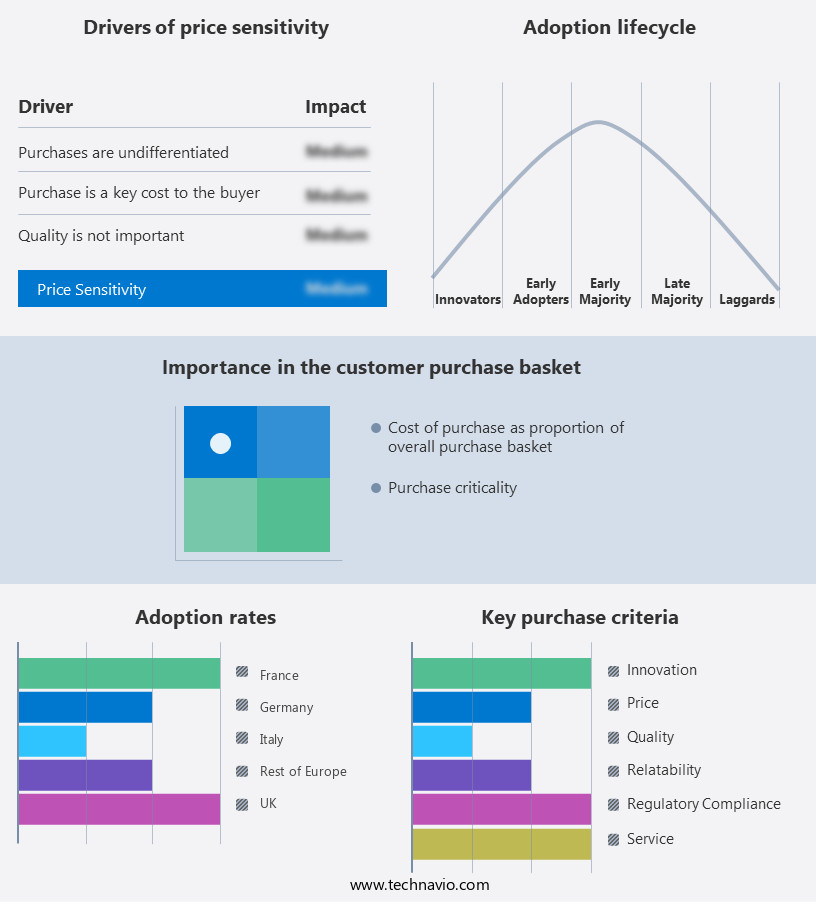
Customer Landscape of Heating, Ventilation, And Air Conditioning (HVAC) Equipment in Europe Industry
Competitive Landscape & Market Insights
Companies are implementing various strategies, such as strategic alliances, Europe heating, ventilation, and air conditioning (hvac) equipment market forecast, partnerships, mergers and acquisitions, geographical expansion, and product/service launches, to enhance their presence in the industry.
Carrier Global Corp. - This company specializes in providing a range of HVAC solutions, encompassing air conditioners, furnaces, heat pumps, ductless systems, and evaporator coils, catering to various heating and cooling needs. Their offerings prioritize energy efficiency and reliability.
The industry research and growth report includes detailed analyses of the competitive landscape of the market and information about key companies, including:
- Carrier Global Corp.
- Daikin Industries Ltd.
- Danfoss AS
- FlaktGroup Holding GmbH
- Haier Smart Home Co. Ltd.
- Honeywell International Inc.
- Ingersoll Rand Inc.
- Johnson and Johnson Services Inc.
- LG Electronics Inc.
- LUVE SpA
- MIDEA Group Co. Ltd.
- Mitsubishi Electric Corp.
- Nortek
- OSTBERG GROUP AB
- Panasonic Holdings Corp.
- Regal Rexnord Corp.
- Robert Bosch GmbH
- Samsung Electronics Co. Ltd.
- Systemair AB
- Zehnder Group AG
Qualitative and quantitative analysis of companies has been conducted to help clients understand the wider business environment as well as the strengths and weaknesses of key industry players. Data is qualitatively analyzed to categorize companies as pure play, category-focused, industry-focused, and diversified; it is quantitatively analyzed to categorize companies as dominant, leading, strong, tentative, and weak.
Recent Development and News in Heating, Ventilation, And Air Conditioning (HVAC) Equipment Market In Europe
- In January 2024, Danfoss, a leading manufacturer of HVAC and refrigeration solutions, announced the launch of their new line of energy-efficient air conditioning compressors in Europe. This innovative product line, named "EcoTM," is designed to reduce energy consumption by up to 15% compared to traditional compressors (Danfoss Press Release, 2024).
- In March 2024, Johnson Controls, a global leader in HVAC and building technologies, entered into a strategic partnership with Siemens Energy Management, aiming to integrate their respective building automation systems for enhanced energy efficiency and optimized performance (Johnson Controls Press Release, 2024).
- In May 2024, Carrier, a leading HVAC manufacturer, completed the acquisition of United Technologies' climate and control technologies business, expanding their portfolio and strengthening their position in the European HVAC market (Carrier Press Release, 2024).
- In February 2025, the European Union passed the new Energy Performance of Buildings Directive (EPBD), which sets stricter energy efficiency requirements for new and existing buildings, driving demand for advanced HVAC technologies and solutions (European Parliament Press Release, 2025).
Dive into Technavio's robust research methodology, blending expert interviews, extensive data synthesis, and validated models for unparalleled Europe Heating, Ventilation, And Air Conditioning (Hvac) Equipment Market insights. See full methodology.
|
Market Scope
|
|
Report Coverage
|
Details
|
|
Page number
|
166
|
|
Base year
|
2023
|
|
Historic period
|
2018-2022 |
|
Forecast period
|
2024-2028
|
|
Growth momentum & CAGR
|
Accelerate at a CAGR of 5.57%
|
|
Market growth 2024-2028
|
USD 10.8 billion
|
|
Market structure
|
Fragmented
|
|
YoY growth 2023-2024(%)
|
4.61
|
|
Key countries
|
Germany, UK, France, Italy, and Rest of Europe
|
|
Competitive landscape
|
Leading Companies, Market Positioning of Companies, Competitive Strategies, and Industry Risks
|
Request Free Sample
Research Analyst Overview
- In Europe's evolving Heating, Ventilation, and Air Conditioning (HVAC) landscape, smart HVAC controllers and air quality monitoring systems are gaining significant traction. These advanced technologies enable building automation, optimizing energy efficiency metrics and enhancing thermal comfort. Air filtration technology plays a crucial role in HVAC equipment's lifecycle, ensuring cleaner indoor air and reducing energy consumption. HVAC load calculations and ventilation system designs are being refined, adhering to stringent building energy codes. Energy efficiency metrics are at the forefront of market activities, with HVAC system diagnostics and demand-controlled ventilation systems becoming increasingly popular. Air conditioning refrigerant choices are shifting towards more eco-friendly alternatives, while thermal comfort modeling and chiller plant operation are being optimized for improved performance.
- Heating system controls and HVAC commissioning processes are undergoing transformations, with thermal storage systems and variable refrigerant flow gaining ground. Cooling tower performance is being enhanced through innovative technologies, and pneumatic control systems are being replaced with more efficient digital alternatives. HVAC maintenance schedules are being streamlined through advanced HVAC control strategies, including heat pump technology and energy recovery ventilation. Heat exchanger efficiency is being maximized, and refrigerant leak detection technologies are being refined to minimize environmental impact. Market dynamics continue to evolve, with a focus on reducing energy consumption, improving air quality, and optimizing building automation systems.
- These trends are shaping the future of Europe's HVAC market, making it an exciting space for innovation and growth.
What are the Key Data Covered in this Europe Heating, Ventilation, And Air Conditioning (Hvac) Equipment Market Research and Growth Report?
-
What is the expected growth of the Europe Heating, Ventilation, And Air Conditioning (Hvac) Equipment Market between 2024 and 2028?
-
What segmentation does the market report cover?
-
The report is segmented by End-user (Non-residential and Residential), Product (Air conditioning equipment, Heating equipment, and Ventilation equipment), and Geography (Europe)
-
Which regions are analyzed in the report?
-
What are the key growth drivers and market challenges?
-
Who are the major players in the Heating, Ventilation, And Air Conditioning (HVAC) Equipment Market in Europe?
-
Carrier Global Corp., Daikin Industries Ltd., Danfoss AS, FlaktGroup Holding GmbH, Haier Smart Home Co. Ltd., Honeywell International Inc., Ingersoll Rand Inc., Johnson and Johnson Services Inc., LG Electronics Inc., LUVE SpA, MIDEA Group Co. Ltd., Mitsubishi Electric Corp., Nortek, OSTBERG GROUP AB, Panasonic Holdings Corp., Regal Rexnord Corp., Robert Bosch GmbH, Samsung Electronics Co. Ltd., Systemair AB, and Zehnder Group AG
Market Research Insights
- The European HVAC equipment market continues to evolve, driven by advancements in technology and increasing focus on energy efficiency. According to industry estimates, the market value is projected to reach €70 billion by 2025, growing at a compound annual growth rate of 3.5% from 2020. This expansion is underpinned by the rising demand for energy-efficient solutions, such as zoned HVAC systems and heat recovery systems, which offer improved indoor environmental quality and reduced energy consumption. Moreover, the adoption of precision air conditioning and HVAC system upgrades is gaining traction, with energy audit services playing a crucial role in identifying opportunities for optimization.
- HVAC design software and HVAC sensor technology are also becoming essential tools for architects and engineers to ensure building climate control and minimize pressure drop calculations. The market is further characterized by the growing popularity of ventilation effectiveness testing and HVAC system retrofitting to enhance air change rates and improve overall system reliability.
We can help! Our analysts can customize this Europe heating, ventilation, and air conditioning (hvac) equipment market research report to meet your requirements.
Get in touch
1 Executive Summary
- 1.1 Market overview
- Executive Summary - Chart on Market Overview
- Executive Summary - Data Table on Market Overview
- Executive Summary - Chart on Country Market Characteristics
- Executive Summary - Chart on Market by Geography
- Executive Summary - Chart on Market Segmentation by End-user
- Executive Summary - Chart on Market Segmentation by Product
- Executive Summary - Chart on Incremental Growth
- Executive Summary - Data Table on Incremental Growth
- Executive Summary - Chart on Company Market Positioning
2 Market Landscape
- 2.1 Market ecosystem
- Parent Market
- Data Table on - Parent Market
- 2.2 Market characteristics
- Market characteristics analysis
3 Market Sizing
- 3.1 Market definition
- Offerings of companies included in the market definition
- 3.2 Market segment analysis
- 3.4 Market outlook: Forecast for 2023-2028
- Chart on Europe - Market size and forecast 2023-2028 ($ billion)
- Data Table on Regional - Market size and forecast 2023-2028 ($ billion)
- Chart on Europe: Year-over-year growth 2023-2028 (%)
- Data Table on Regional - Market size and forecast 2023-2028 ($ billion)
4 Historic Market Size
- 4.1 Heating, Ventilation, And Air Conditioning (HVAC) Equipment Market in Europe 2018 - 2022
- Historic Market Size - Data Table on Heating, Ventilation, And Air Conditioning (HVAC) Equipment Market in Europe 2018 - 2022 ($ billion)
- 4.2 End-user segment analysis 2018 - 2022
- Historic Market Size - End-user Segment 2018 - 2022 ($ billion)
- 4.3 Product segment analysis 2018 - 2022
- Historic Market Size - Product Segment 2018 - 2022 ($ billion)
- 4.4 Geography segment analysis 2018 - 2022
- Historic Market Size - Geography Segment 2018 - 2022 ($ billion)
5 Five Forces Analysis
- 5.1 Five forces summary
- Five forces analysis - Comparison between 2023 and 2028
- 5.2 Bargaining power of buyers
- Bargaining power of buyers - Impact of key factors 2023 and 2028
- 5.3 Bargaining power of suppliers
- Bargaining power of suppliers - Impact of key factors in 2023 and 2028
- 5.4 Threat of new entrants
- Threat of new entrants - Impact of key factors in 2023 and 2028
- 5.5 Threat of substitutes
- Threat of substitutes - Impact of key factors in 2023 and 2028
- 5.6 Threat of rivalry
- Threat of rivalry - Impact of key factors in 2023 and 2028
- 5.7 Market condition
- Chart on Market condition - Five forces 2023 and 2028
6 Market Segmentation by End-user
- 6.1 Market segments
- Chart on End-user - Market share 2023-2028 (%)
- Data Table on End-user - Market share 2023-2028 (%)
- 6.2 Comparison by End-user
- Chart on Comparison by End-user
- Data Table on Comparison by End-user
- 6.3 Non-residential - Market size and forecast 2023-2028
- Chart on Non-residential - Market size and forecast 2023-2028 ($ billion)
- Data Table on Non-residential - Market size and forecast 2023-2028 ($ billion)
- Chart on Non-residential - Year-over-year growth 2023-2028 (%)
- Data Table on Non-residential - Year-over-year growth 2023-2028 (%)
- 6.4 Residential - Market size and forecast 2023-2028
- Chart on Residential - Market size and forecast 2023-2028 ($ billion)
- Data Table on Residential - Market size and forecast 2023-2028 ($ billion)
- Chart on Residential - Year-over-year growth 2023-2028 (%)
- Data Table on Residential - Year-over-year growth 2023-2028 (%)
- 6.5 Market opportunity by End-user
- Market opportunity by End-user ($ billion)
- Data Table on Market opportunity by End-user ($ billion)
7 Market Segmentation by Product
- 7.1 Market segments
- Chart on Product - Market share 2023-2028 (%)
- Data Table on Product - Market share 2023-2028 (%)
- 7.2 Comparison by Product
- Chart on Comparison by Product
- Data Table on Comparison by Product
- 7.3 Air conditioning equipment - Market size and forecast 2023-2028
- Chart on Air conditioning equipment - Market size and forecast 2023-2028 ($ billion)
- Data Table on Air conditioning equipment - Market size and forecast 2023-2028 ($ billion)
- Chart on Air conditioning equipment - Year-over-year growth 2023-2028 (%)
- Data Table on Air conditioning equipment - Year-over-year growth 2023-2028 (%)
- 7.4 Heating equipment - Market size and forecast 2023-2028
- Chart on Heating equipment - Market size and forecast 2023-2028 ($ billion)
- Data Table on Heating equipment - Market size and forecast 2023-2028 ($ billion)
- Chart on Heating equipment - Year-over-year growth 2023-2028 (%)
- Data Table on Heating equipment - Year-over-year growth 2023-2028 (%)
- 7.5 Ventilation equipment - Market size and forecast 2023-2028
- Chart on Ventilation equipment - Market size and forecast 2023-2028 ($ billion)
- Data Table on Ventilation equipment - Market size and forecast 2023-2028 ($ billion)
- Chart on Ventilation equipment - Year-over-year growth 2023-2028 (%)
- Data Table on Ventilation equipment - Year-over-year growth 2023-2028 (%)
- 7.6 Market opportunity by Product
- Market opportunity by Product ($ billion)
- Data Table on Market opportunity by Product ($ billion)
8 Customer Landscape
- 8.1 Customer landscape overview
- Analysis of price sensitivity, lifecycle, customer purchase basket, adoption rates, and purchase criteria
9 Geographic Landscape
- 9.1 Geographic segmentation
- Chart on Market share by geography - 2023-2028 (%)
- Data Table on Market share by geography - 2023-2028 (%)
- 9.2 Geographic comparison
- Chart on Geographic comparison
- Data Table on Geographic comparison
- 9.3 Germany - Market size and forecast 2023-2028
- Chart on Germany - Market size and forecast 2023-2028 ($ billion)
- Data Table on Germany - Market size and forecast 2023-2028 ($ billion)
- Chart on Germany - Year-over-year growth 2023-2028 (%)
- Data Table on Germany - Year-over-year growth 2023-2028 (%)
- 9.4 UK - Market size and forecast 2023-2028
- Chart on UK - Market size and forecast 2023-2028 ($ billion)
- Data Table on UK - Market size and forecast 2023-2028 ($ billion)
- Chart on UK - Year-over-year growth 2023-2028 (%)
- Data Table on UK - Year-over-year growth 2023-2028 (%)
- 9.5 France - Market size and forecast 2023-2028
- Chart on France - Market size and forecast 2023-2028 ($ billion)
- Data Table on France - Market size and forecast 2023-2028 ($ billion)
- Chart on France - Year-over-year growth 2023-2028 (%)
- Data Table on France - Year-over-year growth 2023-2028 (%)
- 9.6 Italy - Market size and forecast 2023-2028
- Chart on Italy - Market size and forecast 2023-2028 ($ billion)
- Data Table on Italy - Market size and forecast 2023-2028 ($ billion)
- Chart on Italy - Year-over-year growth 2023-2028 (%)
- Data Table on Italy - Year-over-year growth 2023-2028 (%)
- 9.7 Rest of Europe - Market size and forecast 2023-2028
- Chart on Rest of Europe - Market size and forecast 2023-2028 ($ billion)
- Data Table on Rest of Europe - Market size and forecast 2023-2028 ($ billion)
- Chart on Rest of Europe - Year-over-year growth 2023-2028 (%)
- Data Table on Rest of Europe - Year-over-year growth 2023-2028 (%)
- 9.8 Market opportunity by geography
- Market opportunity by geography ($ billion)
- Data Table on Market opportunity by geography ($ billion)
10 Drivers, Challenges, and Opportunity/Restraints
- 10.3 Impact of drivers and challenges
- Impact of drivers and challenges in 2023 and 2028
- 10.4 Market opportunities/restraints
11 Competitive Landscape
- 11.2 Competitive Landscape
- Overview on criticality of inputs and factors of differentiation
- 11.3 Landscape disruption
- Overview on factors of disruption
- 11.4 Industry risks
- Impact of key risks on business
12 Competitive Analysis
- 12.2 Market positioning of companies
- Matrix on companies position and classification
- 12.3 Carrier Global Corp.
- Carrier Global Corp. - Overview
- Carrier Global Corp. - Business segments
- Carrier Global Corp. - Key news
- Carrier Global Corp. - Key offerings
- Carrier Global Corp. - Segment focus
- 12.4 Daikin Industries Ltd.
- Daikin Industries Ltd. - Overview
- Daikin Industries Ltd. - Business segments
- Daikin Industries Ltd. - Key news
- Daikin Industries Ltd. - Key offerings
- Daikin Industries Ltd. - Segment focus
- 12.5 Danfoss AS
- Danfoss AS - Overview
- Danfoss AS - Product / Service
- Danfoss AS - Key offerings
- 12.6 Haier Smart Home Co. Ltd.
- Haier Smart Home Co. Ltd. - Overview
- Haier Smart Home Co. Ltd. - Business segments
- Haier Smart Home Co. Ltd. - Key news
- Haier Smart Home Co. Ltd. - Key offerings
- Haier Smart Home Co. Ltd. - Segment focus
- 12.7 Honeywell International Inc.
- Honeywell International Inc. - Overview
- Honeywell International Inc. - Business segments
- Honeywell International Inc. - Key news
- Honeywell International Inc. - Key offerings
- Honeywell International Inc. - Segment focus
- 12.8 Ingersoll Rand Inc.
- Ingersoll Rand Inc. - Overview
- Ingersoll Rand Inc. - Business segments
- Ingersoll Rand Inc. - Key news
- Ingersoll Rand Inc. - Key offerings
- Ingersoll Rand Inc. - Segment focus
- 12.9 Johnson and Johnson Services Inc.
- Johnson and Johnson Services Inc. - Overview
- Johnson and Johnson Services Inc. - Business segments
- Johnson and Johnson Services Inc. - Key news
- Johnson and Johnson Services Inc. - Key offerings
- Johnson and Johnson Services Inc. - Segment focus
- 12.10 LG Electronics Inc.
- LG Electronics Inc. - Overview
- LG Electronics Inc. - Product / Service
- LG Electronics Inc. - Key news
- LG Electronics Inc. - Key offerings
- 12.11 Mitsubishi Electric Corp.
- Mitsubishi Electric Corp. - Overview
- Mitsubishi Electric Corp. - Business segments
- Mitsubishi Electric Corp. - Key news
- Mitsubishi Electric Corp. - Key offerings
- Mitsubishi Electric Corp. - Segment focus
- 12.12 OSTBERG GROUP AB
- OSTBERG GROUP AB - Overview
- OSTBERG GROUP AB - Product / Service
- OSTBERG GROUP AB - Key offerings
- 12.13 Panasonic Holdings Corp.
- Panasonic Holdings Corp. - Overview
- Panasonic Holdings Corp. - Business segments
- Panasonic Holdings Corp. - Key news
- Panasonic Holdings Corp. - Key offerings
- Panasonic Holdings Corp. - Segment focus
- 12.14 Robert Bosch GmbH
- Robert Bosch GmbH - Overview
- Robert Bosch GmbH - Product / Service
- Robert Bosch GmbH - Key news
- Robert Bosch GmbH - Key offerings
- 12.15 Samsung Electronics Co. Ltd.
- Samsung Electronics Co. Ltd. - Overview
- Samsung Electronics Co. Ltd. - Business segments
- Samsung Electronics Co. Ltd. - Key news
- Samsung Electronics Co. Ltd. - Key offerings
- Samsung Electronics Co. Ltd. - Segment focus
- 12.16 Systemair AB
- Systemair AB - Overview
- Systemair AB - Business segments
- Systemair AB - Key offerings
- Systemair AB - Segment focus
- 12.17 Zehnder Group AG
- Zehnder Group AG - Overview
- Zehnder Group AG - Business segments
- Zehnder Group AG - Key offerings
- Zehnder Group AG - Segment focus
13 Appendix
- 13.2 Inclusions and exclusions checklist
- Inclusions checklist
- Exclusions checklist
- 13.3 Currency conversion rates for US$
- Currency conversion rates for US$
- 13.4 Research methodology
- 13.7 Validation techniques employed for market sizing
- Validation techniques employed for market sizing
- 13.9 360 degree market analysis
- 360 degree market analysis
- 13.10 List of abbreviations







![]() Get the report (PDF) sent to your email within minutes.
Get the report (PDF) sent to your email within minutes.
Complimentary full Excel data with your report purchase.